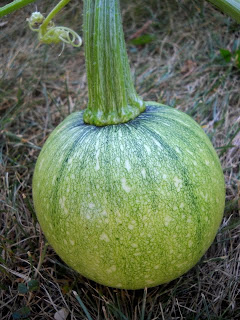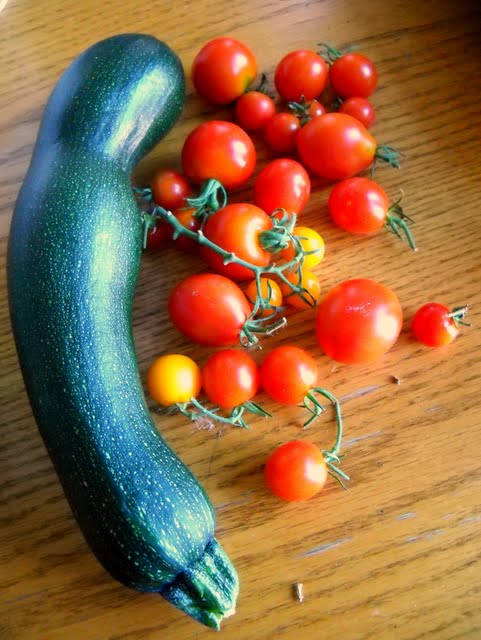Broccoli
After a slow start, the broccoli turned out extremely well! Five of my six plants yielded a nicely sized head of broccoli, and of course, continued to produce side shoots after the main head was cut.
At the end of this post is a little recipe for Broccoli Au Gratin, based on this one. Click here to jump directly to my recipe.
Quick Recap: Started broccoli seeds indoors, moved them outside; when I planted them in the raised bed, they were eaten. I though the culprits were rabbits, so when I put in six new plants, I also put a plastic collar around them. The next day, the plants were still nibbled, about 2 inches below the top of the collars. So the culprits were in fact birds. Not having enough seedlings left, I replaced only five of the plants, this time putting up a net over top of the bed. As the plants grew, I increased the height of the net.
After the plants were large enough, the birds stopped nibbling on them; though rabbits would occasionally snack on the outer leaves; and some kind of insect would nibble small holes. But if I sprinkled torn up basil leaves, I wouldn't get any new nibble holes.
Here are a few shots of my harvests:
This size was typical for my broccoli: (5 August)
After cutting the main head, side shoots formed (7 Aug)! I had enough to harvest maybe once every two weeks.
In early October, sometimes florets began spreading too far apart and blossoming quickly. I had originally intended to save these and pick the flowers off to decorate my baking (maybe atop a cake or muffin or even bread); but didn't have time to bake too often. Photo: 22 Oct.
This was taken on 9 Oct:
The broccoli held up surprisingly well against the light frost, and even the hard frost! I am very impressed. Unfortunately, due to laziness (I didn't want to put on a coat and boots to go outside for only a few seconds), I did not get any good photos of the broccoli before it began wilting.
Here they are on 20 Nov (-13C average temp that day). Apologies for the low quality, I was using my cell phone camera:
As you can see, the leaves are wilting, but not nearly as much as other annuals!
Here is the one broccoli plant who had been harassed by birds early on and had not been replaced by a stronger plant. As you can see, he didn't get big enough to harvest the main head.
For whatever reason, I don't want to pull them out of the garden. This past week, it got up to +9C (Thu 24 Nov), and I swore I was going to pull them out of the garden (and finish all my other gardening chores). But they just fill me with pride and hope. ... I think I'm partly in denial that Winter is actually coming to stay (though now that it's gotten down to -14, I'm starting to be convinced).
I still think that I'll harvest the small broccoli leaves to put in either a soup (or noodles!) or a stir-fry. But I think it may be too late now!
After all this, I have to say I'm extremely impressed with the broccoli. It was completely unaffected by powdery mildew, even though everything else caught it. It was a slow start--will have to protect against birds right from the start next time--but they were just so sweet and crisp and fresh!
I certainly wasn't one of those kids who pouted and crinkled her nose at the prospect of having to eat, ew, broccoli for dinner. But it always seemed mediocre to me--a boring vegetable when it came to flavour. Sure, it looks neat and when it soaks up sauce from a stir fry, but is still firm enough to crunch a little when you bite down and get that explosion of sauce, mmm! But I just wouldn't eat plain broccoli. Until I had these sweeties. I never knew broccoli could be sweet!
Also? With a bechamel sauce, they make quite a fine dish!
 adapted from this recipe
adapted from this recipeHardware
- baking dish just large enough to fit broccoli (err on the side of too small rather than too large); buttered
- pot large enough to blanch broccoli
- medium mixing bowl
Ingredients
- broccoli, 1 head
- bechamel sauce (see below)
- panko crumbs, about 1/2 cup
- olive oil, about 1 Tbsp
- basil, parsley, about 1 teaspoon
- salt, about 1 teaspoon
- black pepper, to taste
Bechamel Sauce
- butter, 2 Tbsp
- flour, 2 Tbsp
- milk, 1 cup
- Swiss cheese, 1 cup grated
- nutmeg, pinch
- bay leaf, 1
Drain broccoli and set aside.
Prepare bechamel sauce:
Melt the butter in a small saucepan and stir in the flour. Cook on low heat stirring for several minutes, or until the roux just starts to brown. Whisk in the milk gradually to form a smooth sauce. Add bay leaf. Warm until just simmering.
Remove the sauce from the heat, remove bay leaf and gradually stir in the cheese, the pepper and the nutmeg.
Preheat oven to 350F.
Arrange broccoli florets upright in a buttered baking dish. Pour sauce over. I personally have the sauce not uniformly spread; leaving some florets uncovered so my diners can taste the vegetable without sauce, for contrast.
Bake for 15 minutes, just to bring up to heat. Meanwhile, make crumb topping: In medium bowl, combine panko crumbs, olive oil, salt and herbs until just moistened.
Carefully remove dish from oven. Top with crumb mixture followed by freshly cracked pepper. Return to oven. Bake (or broil) for another 10-15 minutes or until crust is golden brown.
Serve warm!

















































